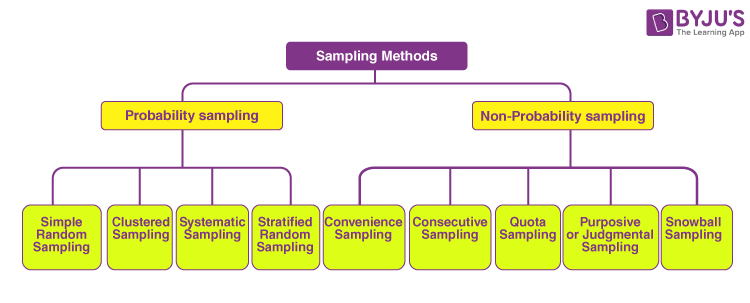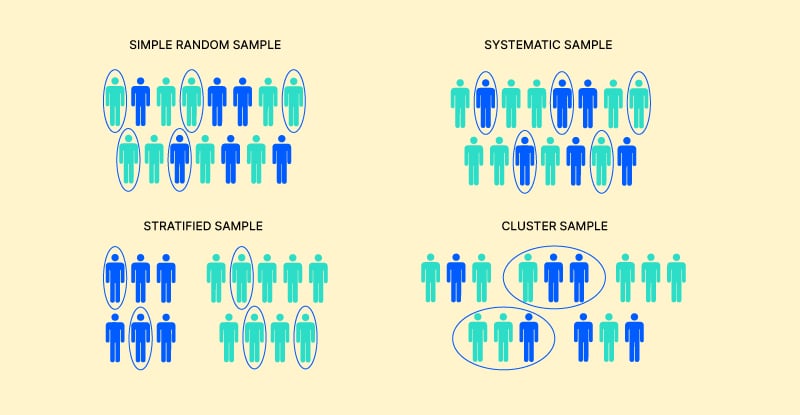This means that you can be absolutely confident about whether your sample is representative or not and you can also put a number on how certain you are about your findings this number is called the significance and is. A stratified sample is a sampling technique in which the researcher divides the entire target population into different subgroups or strata and then randomly selects the final subjects proportionally from the different strata.

Four Types Of Random Sampling Techniques Explained With Visuals By Terence Shin Towards Data Science
Sample designs may be classified into different categories based on two factors namely the representation basis and the element selection technique.

. Sampling reduces the population into small manageable units. Sampling helps a lot in surveys and research where we have to take a sample from a large population. Here let us discuss all these types of non-probability sampling in detail.
1 simple random 2 stratified random 3 cluster and 4 systematic. The sampling method chosen will depend on the situation and priorities of the researcher. Different Types Of Sample Designs.
The elements or the items of the universe numbered or written on separate slips and then it is drawn till we get the required sample size. Researchers choose these samples just because they are easy to recruit and the researcher did. CHART SHOWING BASIC SAMPLING DESIGNS.
It is of two types. Convenience sampling is a non-probability sampling technique where samples are selected from the population only because they are conveniently available to the researcher. Acciden tal samp ling someti mes known as grab convenience or.
Under the representation basis the sample may be classified as. For this the easy way is to take a maximum sample size that is calculated for any one major variable in the. Four main methods include.
This is the superiority of random sampling design over the deliberate sampling design. Iii Flat top sampling. Learn the Techniques involved in sampling.
If you want to produce results that are representative of the whole population probability sampling techniques are the most valid choice. You can implement it using python as shown below population 100 step 5 sample element for element in range1 population step print sample Multistage sampling. A sample is a smaller part of a whole quantitative data that has been collected through surveys or thorough observations.
TYPES OF RESEARCH Chapter 4 In a true experiment The researcher manipulates the IV and determines if different types or amounts of the IV affect the DV differently Provides a method for discovering a cause-and-effect relationship between the IV and DV The researcher attempts to control all variables. Types of Sampling Design. Probability sampling uses random sampling techniques to create a sample.
Basically there are three types of sampling techniques such as. Specifying a sampling frame a set of items or events possible to measure. The exact population will depend on the scope of the study.
The population includes all members from a specified group all possible outcomes or measurements that are of interest. In a questionnaire there are different varities of variables that are used in it which require formula that is necessary for each variable. Acquiring data about sample of population involves lower cost which is one of the major advantage.
Non-probability sampling is that sampling procedure which does not afford any basis for estimating the probability that each item in the population has of being included in the sample. This type of sampling is less likely than probability. The main probability sampling methods are the following.
Sampling takes on two forms in statistics probability sampling and non-probability sampling which are being as follows. Non-probability sampling is also known by different names such as deliberate sampling purposive. Sampling is a method that allows us to get information about the population based on the statistics from a subset of the population sample without having to investigate every individual.
Unrestricted random sampling A simple random sampling is one in which every item of the population has an equal chance of being selected. Specifying a sampling method for selecting items or events from the frame. Here are the types of non-probability sampling methods.
This method is also known as unrestricted random sampling. Opportunity sampling is a type of non-probability sam pling which involves the samp le being. For example convenience sampling where the sample is simply those easily reached and observed.
The above diagram perfectly illustrates what sampling is. Different techniques of Sampling are there to give different types of desired results. In a simple random sample every member of the population has an equal chance of being selected.
Statistical Data Distribution Models In this blog we learned about different Sampling techniques and how they are used. Non-probability sampling the elements that make up the sample are selected by nonrandom methods. There are two types of random sampling.
Lets understand this at a more intuitive level through an example. For example at the first stage cluster sampling can be used to choose. Under Multistage sampling we stack multiple sampling methods one after the other.
Determining the sample size. Concept of SamplingTypesfactors affecting it. Sampling and sample design is an essential factor as it is based on the judgment of the researcher to provide the best information for the objectives study.
Simple Random Sampling. Now let us discuss three different types of. This type of sampling is used when the researcher wants to highlight specific subgroups within the.
Here each element of the frame have an equal probability of being selected. There are four main types of probability sample. Reviewing the sampling process.
Sampling reduces the overall time by reducing the size of population. Defining the population of concern. Probability sampling methods allow the researcher to be precise about the relationship between the sample and the population.
Probability sampling is based on the fact that every number of populations has a known and equal. Simple or unrestricted random sampling. Data is not collected about every member in population but only related to sample is gathered.
Sampling is the process of selecting a group of individuals from a population to study them and characterize the population as a whole. Implementing the sampling plan. A Simple random sampling.
Sampling and data collecting. Out of these three instantaneous sampling is called ideal sampling whereas natural sampling and flat-top sampling are called practical sampling methods. It can be defined as a smaller unit that represents the real data.
Unlike systematic stratified or cluster sampling these types of sampling cannot be easily. Non-probability Sampling methods are further classified into different types such as convenience sampling consecutive sampling quota sampling judgmental sampling snowball sampling. Sometimes non-probability sampling methods will be chosen.

Sampling Methods Simply Psychology

Sampling Methods Techniques Types Of Sampling Methods And Examples

Voxco Guide To Sampling Methods And Types Voxco

Types Of Sampling Methods Simple Techniques And Examples Social Science Research Social Work Research Research Methods
0 Comments